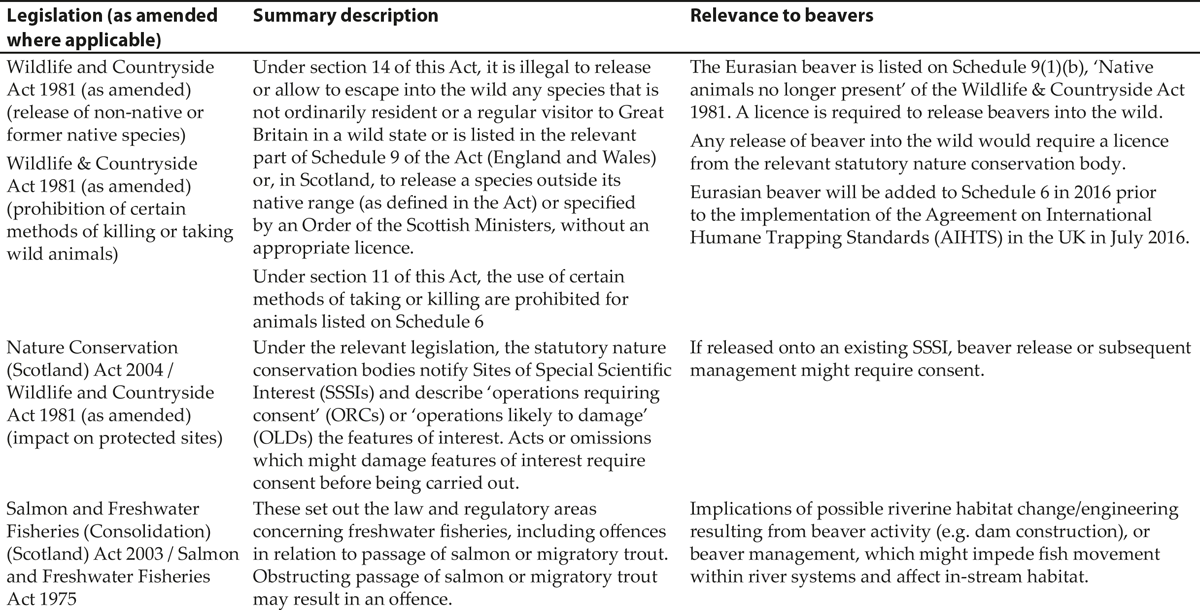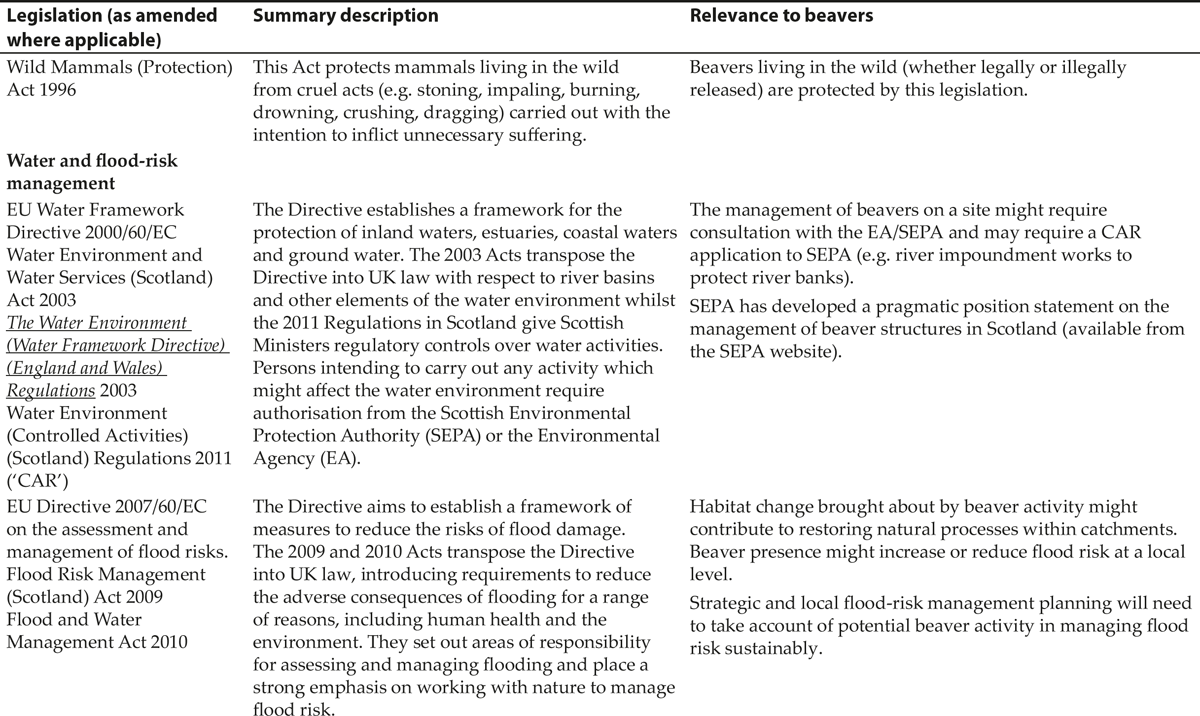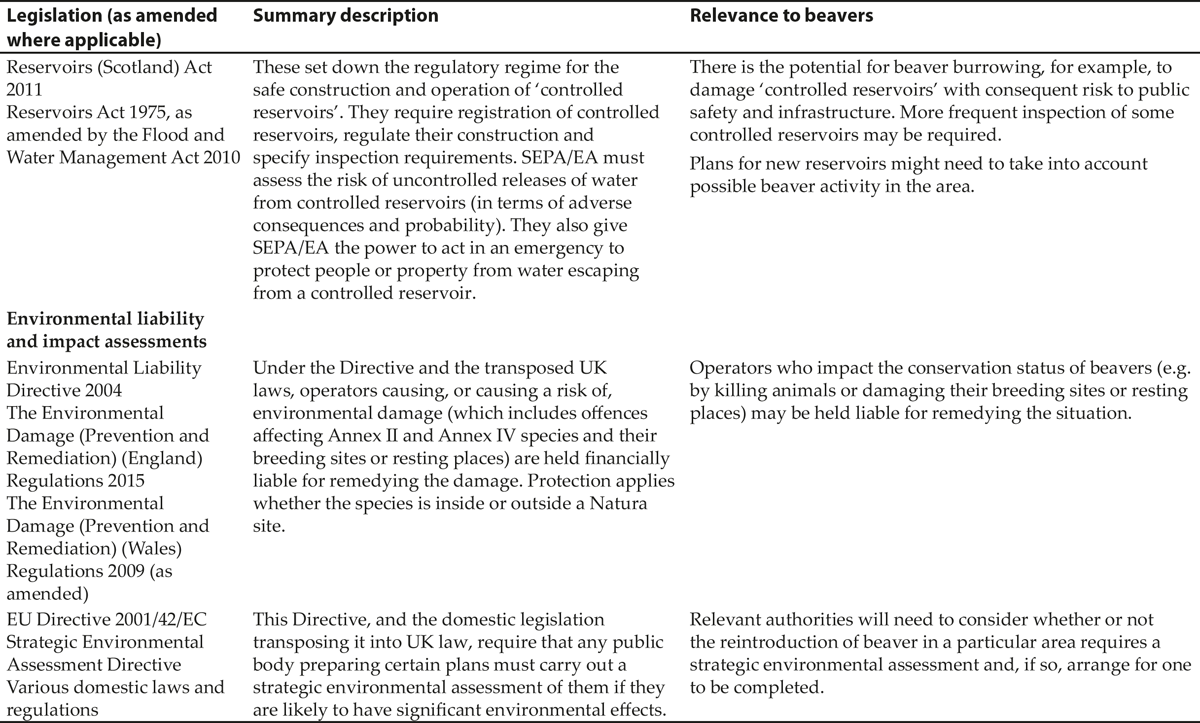
The Eurasian beaver is protected across Europe through a number of legislative measures. The framework for protection is provided by the Convention on the Conservation of European Wildlife and Natural Habitats, and specific provisions are made by European Union Directive 92/43/EEC on the Conservation of Natural Habitats and of Wild Fauna and Flora (the ‘Habitats Directive’; Species of Community Interest in Annex II and Annex IV(a)) (http://ec.europa.eu/environment/nature/legislation/habitatsdirective/index_en.htm). In EU member states (with some specific exceptions), wild beavers present within their natural range are protected from deliberate capture, killing and/or disturbance, and damage or destruction of their breeding sites or resting places. It is also prohibited to keep, transport or offer for exchange or sale specimens taken from the wild. Additional protection of beaver habitats is afforded through other legislation such as the Ramsar Convention and by the Natura 2000 network.
The Habitats Directive is transposed into domestic legislation in England and Wales by the Conservation of Habitats and Species Regulations 2010 and in Scotland by the Conservation (Natural Habitats, &c.) Regulations 1994 (as amended). Table 4.1 summarises the main legislation that would apply to the Eurasian beaver in Britain. Under domestic law, it is an offence to keep beavers taken from the wild (unless it can be shown the beavers originated from outside the EU), except under licence by the relevant authority (Natural England, Scottish Natural Heritage or Natural Resources Wales), unless it can be proven that they are lawfully held, having been taken from the wild in an EU member state without contravention of the law and before the implementation date of the Directive (10 June 1994 for most member states, later for some accession countries). Captive-bred offspring are only considered such (and therefore exempt from this requirement) if their parents were lawfully held in captivity. However, the beaver is not currently listed in the Regulations as a ‘European Protected Species’, therefore, at the time of writing, the full protection afforded by the Directive is not transposed into domestic law. Formal reintroduction, for example, following the successful Scottish Beaver Trial in Scotland, is likely to require the addition of beavers to the Regulations, thus affording them full protection.
In England and Wales, section 14 of the Wildlife and Countryside Act (1981) prohibits the release of any animal not ordinarily resident, or a regular visitor in Great Britain in a wild state, or which is listed in Schedule 9. The Eurasian beaver was recently listed in Schedule 9, Part 1B (‘Animals no longer normally present’; amended by the Infrastructure Act 2015), so their release, without a licence, is prohibited. In Scotland, section 14 of the Wildlife and Countryside Act (1981) (as amended) prohibits the release, without a licence, of any animal outside of its native range. Scottish Natural Heritage currently considers beavers to be outside of their ‘native range’ when in Scotland, as defined under the Wildlife and Natural Environment (Scotland) Act 2011 and the Habitats Directive.
Beavers, like all wild mammals, are afforded limited protection against cruel acts, or unnecessary suffering, by the Wild Mammals (Protection) Act 1996, animal-welfare legislation and hunting legislation.
Due to expansion in beaver populations and distribution in Eurasia in recent decades, the beaver was recently downgraded on the International Union for Conservation of Nature (IUCN) Red List of threatened species to ‘Least Concern’, the most favourable conservation status. However, conservation measures are still recommended, including closed hunting seasons, temporary or local bans on particular exploitations, and the regulation of trade in live or dead specimens, in order to ensure that the species does not once again become endangered (Batbold et al. 2008, http://conventions.coe.int/Treaty/EN/Treaties/Html/104.htm). This downgrading does not affect the status of Eurasian beavers under the Bern Convention or the Habitats Directive.
Key concepts
•The Eurasian beaver is listed in the Habitats Directive as a Species of Community Interest, though several countries have reduced protection status, allowing management options such as regulated hunting while maintaining favourable conservation status.
•Currently, a licence is required under the Wildlife & Countryside Act, to release, possess or transport beavers in Britain.
•Future legislation is likely to change and potentially differ between Scotland, England and Wales, and therefore the relevant Statutory Nature Conservation Organisations should be consulted before undertaking any beaver management.
Table 4.1 Current legislation most relevant to Eurasian beavers in Britain (modified from SNH 2015, with additional information provided by Natural England). The authors would recommend seeking legal advice when necessary and checking with the relevant statutory authority.





